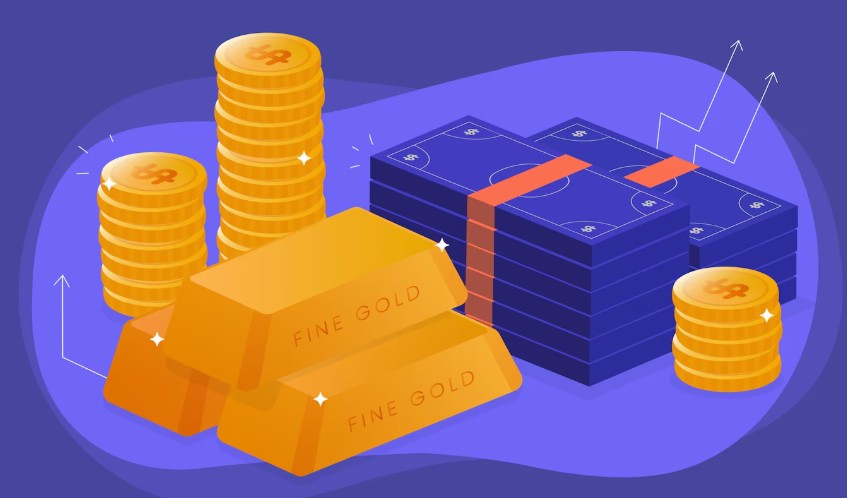Exchange Traded Funds (ETFs) of gold means that gold investors do not need to hold physical gold to participate in the gold market. Gold ETFs provide an opportunity for investors to invest in gold easily and affordably without having to deal with the challenge of keeping physical gold. In the following article, we will learn all that is relevant to the Gold ETFs, from the mechanics behind them to their potential advantages, who and when they should be used.
Understanding Gold ETFs

A Gold ETF is an exchange-traded fund that essentially gives it’s holders a stake in gold holdings. A person’s share of a Gold ETF is normally equivalent to a definite weight of gold (e.g., one gram), and the price of the ETF follows the fluctuation of the market value of gold. Since Gold ETFs trade in major stock exchanges, they provide the investors the convenience and convenience of trading that stocks enjoy.
How Do Gold ETFs Work?
Gold ETFs seek to reflect the movement in the gold market. By purchasing a Gold ETF your money is broken up and used to purchase lifesize gold stored in safe, guarded locations managed by the fund manager. The value of the investment moves up and down right with the world price of gold.
For an instance, if the price of gold increases by 5%, your Gold ETF’s worth is determined to also increase by the same percentage, i.e., 5%. Ordinarily, the price of gold will reduce and thus; the value of your Gold ETF will also shrink.

Investors can transact Gold ETFs on the exchange each day at the daily rates for trading, as for common stocks. The flexibility also makes Gold ETFs an adaptational investment avenue.
Types of Gold ETFs
Gold ETFs can be categorized into two main types:
1. Physical Gold ETFs
Investors holding physical gold ETFs are entitled to be awarded gold that is stored physically in vaults as collateral. Investors have a direct claim on gold, with the quantity tied to the price via the ETF’s shares.
2. Synthetic Gold ETFs

Unlike the physical Gold ETFs which literally hold gold, the synthetic Gold ETFs imitate the gold price changes via financial instruments such as the futures contracts, options and derivatives. Unlike the traditional physical Gold ETFs, these funds invest in instruments whose movement closely tracks the fluctuations on the price of gold instead of having people own gold.
Benefits of Investing in Gold ETFs

Gold ETFs have become a popular investment choice for several reasons:
1. Convenience
By holding Gold ETFs investors can have exposure to gold without experiencing the hassles of buying, safeguarding and insuring physical gold.
2. High Liquidity
Because they trade on stock exchanges, Gold ETFs provides fast and easy transactions during market hours with continuous liquidity.
3. Transparent Pricing
The Gold ETF value moves together with the price of gold on the market, ensuring investors’ transparent pricing.
4. Cost-Effective

Investors avoid the additional costs attached to the physical gold ownership, making charges, storage, and insurance. Most investors experience low expense ratios with Gold ETFs.
5. Purity Guarantee
Since the Gold ETFs are backed by gold at 99.5% purity or higher purity, investors have no reason to worry that their investment is standard high quality.
6. Portfolio Diversification
Gold is considered a safe-haven asset that has consistently outshone over a period of economic meltdown. Investing in Gold ETFs carries the benefit of additional diversification and the protection from the greater market risks.
How to Invest in Gold ETFS?
Investing in Gold ETFs is a straightforward process:

- Choose a Brokerage Account: Open an account with a brokerage platform that offers access to Gold ETFs.
- Select the Right Gold ETF: Research different Gold ETFs available on the stock exchange and choose the one that suits your investment goals.
- Place an Order: You can buy Gold ETFs by placing a market order (buying at the current price) or a limit order (buying at a specific price).
- Monitor Your Investment: Keep track of the performance of your Gold ETF and make adjustments as needed.
Who Should Invest in Gold ETFs?
Gold ETFs are suitable for various types of investors:
- Beginner Investors: Gold ETFs provide a simple way to gain exposure to gold without the need for physical storage.
- Experienced Investors: They can be used to diversify an existing portfolio and hedge against market volatility.
- Investors Looking for Liquidity: Gold ETFs can be quickly bought or sold during market hours.
- Investors Seeking Transparent Pricing: Since Gold ETFs track gold prices, investors benefit from clear and transparent pricing.
How to Choose the Right Gold ETF?
When selecting a Gold ETF, consider the following factors:
1. Expense Ratio
The expense ratio is the annual fee charged by the ETF provider. Choose a Gold ETF with a low expense ratio to maximize your returns.
2. Tracking Error

Tracking error measures how closely the Gold ETF follows the price of gold. Choose an ETF with a low tracking error for better performance.
3. Fund Size and Liquidity
Larger Gold ETFs with higher assets under management (AUM) are generally more stable and liquid.
4. Purity of Gold
Ensure that the Gold ETF is backed by high-purity gold (99.5% or higher).
5. Fund Provider Reputation
Invest in Gold ETFs offered by reputable fund providers such as SPDR Gold Shares (GLD), iShares Gold Trust (IAU), and Nippon India Gold ETF.
Risks of Investing in Gold ETFs
While Gold ETFs offer many benefits, they also come with certain risks:

- Price Volatility: Gold prices can fluctuate based on global economic conditions, interest rates, and geopolitical factors.
- Currency Risk: If you invest in international Gold ETFs, the value of your investment may be affected by currency fluctuations.
- Management Fees: Although low, expense ratios can still reduce your overall returns.
- Tracking Error: Gold ETFs may not perfectly mirror gold prices due to tracking error.
Conclusion
Gold ETFs are an excellent investment option for those looking to gain exposure to gold without the hassles of buying, storing, or insuring physical gold. They offer convenience, liquidity, transparency, and cost-effectiveness, making them suitable for investors of all experience levels.
Whether you are looking to diversify your portfolio, hedge against inflation, or invest in a safe-haven asset, Gold ETFs can be a valuable addition to your investment strategy. However, like any investment, it is essential to understand the risks involved and choose the right Gold ETF that aligns with your financial goals.
Read more on our blog.

